Interpreting Omega-3 Blood Tests
Column #148 
Lipid Technologies (LT) is my favorite testing lab for analyzing essential fatty acid (EFA) profiles. I use them frequently to analyze meats and other food products. What’s most exciting for the consuming public is their simple, self-testing, mail-in blood test. The results along with the interpretations are available in a couple of weeks by mail or email.
LT provides a brochure targeted to physicians to assist them in interpreting the test results. But unless one has been studying EFA science for awhile, the wording and tables can be confusing. Unfortunately even most doctors don’t understand it so I’m going to condense and simplify LT’s brochure to hopefully provide a layman’s interpretation. The tables are from the brochure.
Why Should We Care About Our EFA Profile?
Inflammation is a component of the body’s immune response to injury and illness. When functioning properly, it assists in the restoration of health. Inflammation occurs at the cellular level, where our bodies store and release EFAs. The Omega-6 EFAs facilitate a pro-inflammatory response. Omega-3s counteract the Omega-6 with an anti-inflammatory response.
In addition to inflammation, the brain, nerves, and immunity are also impacted by the EFA balance. Omega-6 to Omega-3 balances of 1:1 are associated with far better health than balances that exceed 5:1.
How to Know the Body’s Omega-3 Fatty Acid Status
During the past 40 years numerous scientific studies have provided evidence that higher amounts of Omega-3 fatty acids EPA, DPA, and DHA, and lower amounts of Omega-6 fatty acids in the blood, are associated with reduced risk of many cardiovascular problems.
The imbalance in Omega-3 and Omega-6 fatty acids within cell membranes is primarily the result of a nutrient deficient diet. Research suggests that a large number of Americans carry 75% pro-inflammatory Omega-6 fatty acids and only 25% anti-inflammatory EPA, DPA, and DHA in their cell membranes.
By using an Omega-3 Blood-Spot Test, a person can determine the balance of their EFAs and follow the changes in their EFA balance as they work to improve their diet and use Omega-3 supplements. Research also indicates that when Omega-3 EPA, DPA, and DHA levels in cell membranes are at or above 50% of highly unsaturated fatty acids (HUFA) the risk of cardiovascular problems is significantly reduced (see graph below). My goal is to stay above 60% Omega-3 in total HUFA.
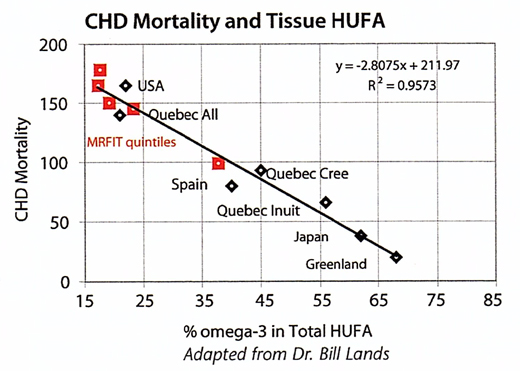
Omega-3 Index
Similar to the Omega-3 Blood Spot Test, the Omega-3 Index Test evaluates the amount of Omega-3 fatty acids in red blood cell (RBC) membranes, but reports the results in a different manner. When levels of EPA plus DHA in cell membranes are at or above 8%, the risk of cardiovascular problems is significantly reduced (see graph below). My goal is to keep my EPA plus DHA total above 10%.
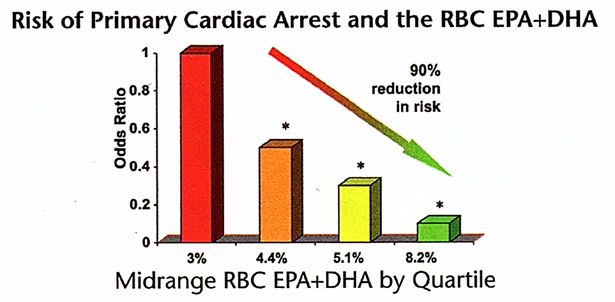
Deciphering Test Results
Test results are an analysis of the Omega-3 and Omega-6 EFAs in cell membranes. The results are presented in several formats (e.g. scores, ratios) that compare the subject’s results with the typical USA population average and an initial target for noticeable change (optimal). My numbers are: Total Omega-3 Score = 18.6%, Omega-6/Omega-3 ratio = 1.5 which is 1.5:1, and AA/EPA = 1 or 1:1. As you can see all of my scores are significantly better than “Optimal” which is a minimum threshold.
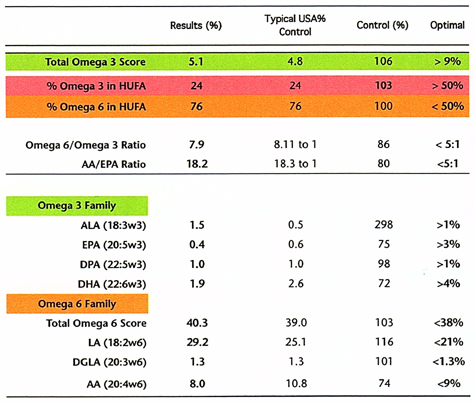
With quarterly tests, patients can track their progress and observe how changes in diet and supplement intake restore the balance of Omega-3 and Omega-6 EFAs. The test results are also helpful in developing individualized dosing protocols to correct Omega-3 deficiencies. Then as goals are reached, annual tests may suffice to keep one on target. The objective is to move your star into the point of the arrow. My score of 18.6% is far beyond the arrowhead.
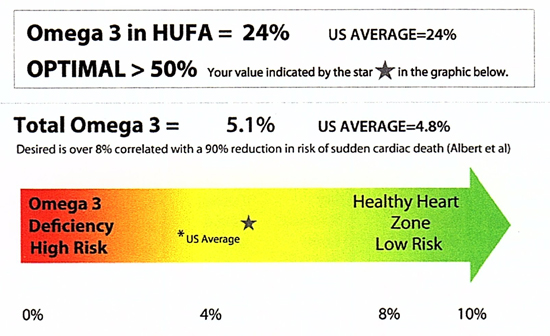
The Role of Diet in Omega-3 Deficiency
When addressing the EFA balance subjects must understand that Omega-6 fatty acids compete with Omega-3 fatty acids in the body. With a high Omega-6 diet, the metabolism and assimilation of Omega-3 fatty acids will be reduced. That is the basis for Bill Lands’ recommendation to “Nix the 6 and Eat the 3.”
Nix the Six by reducing these high Omega-6 foods as much as possible:
● Cooking Oils: Corn, Safflower, Sunflower
● Grain-fed Meats and Dairy
● Tofu and Soy-based Products
● All Grains and Corn
● Sunflower, Sesame, Pumpkin, and Poppy Seeds
● Peanuts, Almonds, Pecans, Walnuts, Butters Made from Nuts
Eat the 3 by eating more foods high in Omega-3 and/or low in Omega-6:
● Grass-Fed and Omega-3 Meats
● Fish: Wild, Cold-Water Fish Such as Salmon, Cod, Herring, Mackerel, Sardines, and Anchovies
● Leafy, Dark-green Vegetables: Kale, Broccoli, Spinach
● Zucchini, Spaghetti Squash
● Kidney, Navy, and Pinto Beans
● Sea Vegetables: Algae, Spirulina, Kelp, Etc.
● Flax, Chia, Hempseed
● Fruits Such as Cranberries, Grapefruit, Strawberries, Blueberries
Omega-3 Supplementation
Dosing: There is evidence-based recommendations for raising Omega-3 levels above 50% in the tissues of an average subject consuming a stable 2,000 kcal diet. Its assumes the subject’s diet mostly foods low in Omega-6 fatty acids.
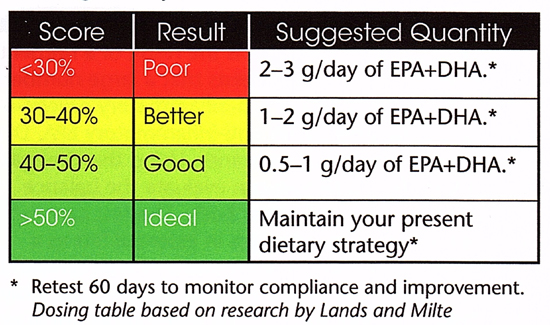
Choosing an Omega-3 Fish Oil
Omega-3 supplements vary widely in molecular form (bioavailability), purity and freshness (contaminants, taste), type of processing, and company commitment to sustainable fishing practices.
TRIGLYCERIDE FORM: Both short- and long-term studies suggest that triglyceride-form EPA and DHA may be incorporated into cell membranes more efficiently than when consumed as ethyl-esters. Omega-3 acid ethyl esters are the omega-3 fatty acids eicosapentaenoic acid (EPA) and docosahexaenoic acid (DHA), i.e., the ester part, attached at one end to an ethanol molecule - the ethyl part. These are actually FDA-approved prescription products.
MOLECULAR DISTILLATION: This process removes oxidized by-products, heavy metals, and other contaminants without damaging the structural integrity of important EPA and DHA fats. The result is fish oil that has a fresh, clean taste and is safe for people of all ages. Purity should be verified through independent third-party laboratory analysis.
Do you know if you are on track for better health? Without measuring you’ll never know.
To your health.
Ted Slanker
Ted Slanker has been reporting on the fundamentals of nutritional research in publications, television and radio appearances, and at conferences since 1999. He condenses complex studies into the basics required for health and well-being. His eBook, The Real Diet of Man, is available online.
Don't miss these links for additional reading:
The Importance of the Ratio of Omega 6 Omega 3 Essential Fatty Acids by Artemis Simopoulos M.D.
Ted Slanker’s Omega-3 Blood Test
Get Your Own Omega-3 Blood Test and use slanker as a code for a discount
Bill Lands’ EFA Education Website
Food Analysis: GI, GL, Fat Ratio, Nutrient Load by Ted Slanker
How Fast Can the EFA Ratio Change? by Ted Slanker
Overview of Omega-3 Fatty Acid Therapies by J. Chris Bradberry, et al.
Which Omega-3 is Better For Lowering Triglyceride Levels?
Fish Oil: Hazardous to Health? by Ted Slanker




